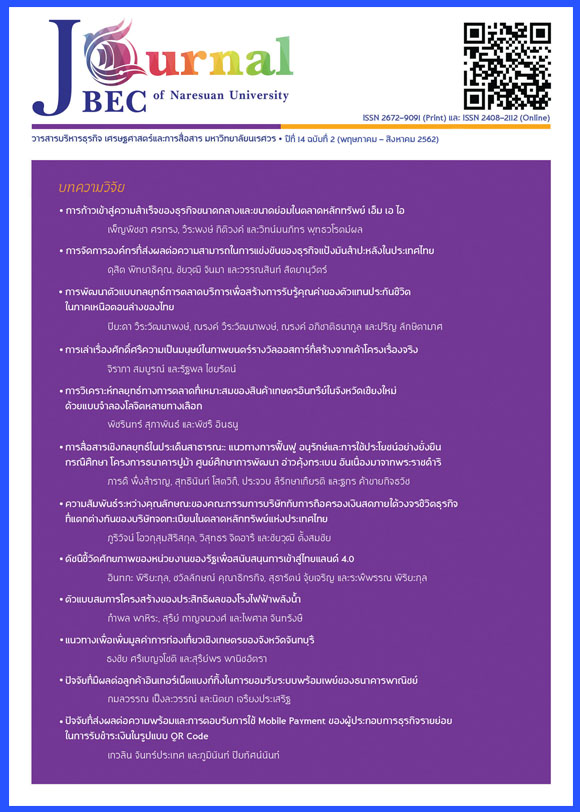Guideline for Adding Value to Agro-Tourism in Chanthaburi Province
Main Article Content
Abstract
Chanthaburi province has a varied agro-tourism management style, especially, fruit buffet which gains a lot of attention from tourists. However, some of the tourists’ expectations are not met. The study on agro-tourism marketing in Chanthaburi province aimed for analyzing consumer’s surplus and proposing marketing guidelines for agro-tourism in Chanthaburi province.Methods used in the study were the data analysis, percentage, mean, statistics, T-Test, Individual Travel Cost Method (ITCM), and content analysis. The results revealed that the tourists were not satisfied in the management of agro-tourism in Chanthaburi province. Their preferences related to the following: product; product quality, price; cheaper price, place; convenience of accessibility of tourist attractions, and public relations; direction signs/public relations boards. The consumers’ surplus was -1,771.012 baht/person. Suggestions from the study were product—promoting the differences, selling values of products to boost product values, price—halting buffet sales and promoting more reasonable price for customers as well as explaining the pricing to them, place—developing more convenient facilities to reach the attractions, arranging appropriate places with enough space for a parking lot, marketing promotion—developing and promoting through online, establishing good relationships with customers and penetrating leading tourist agency market.
Article Details
References
2. Bejranonda, S. (2000). Environmental economics. Bangkok: Kasetsart University Press.
3. Bejranonda, S. (2002). Indirect environmental value measurement. Environmental Economics. Nonthaburi: The Office of the University Press Sukhothai Thammathirat Open University.
4. Chankaew, P., Hoamuangkaew, W. and Suksard, S. (2013). The valuation of recreational value of Wiang Kosai National Park, Phrae Province and Lampang Province. Thai Journal of Forestry, 32(Supplementary issue), 195-203.
5. Chemnasiri, N. (2013). Community potential development for sustainable agro-tourism: Cases in Phuket and Chonburi, Thailand. Chandrakasem Rajabhat University Journal, 19(36), 41-50.
6. Department of Agricultural Extension. (2016). Information on plant production 2015. Retrieved June 2, 2016, from http://www.agriinfo.doae.go.th/year59/plant/rortor/fruit.pdf
7. Donkwa, K. and Tikul, J. (2014). The quality development of agro tourism in northeast Thailand. Suranaree Journal of Social Science, 8(1), 55-71.
8. Kamlangngam, S., Kaewkamcharn, S. and Yooprayong, N. (2007). The study of tourists’ consumption behavior in cultural tourism in the lower northeastern region. Bangkok: The Thailand Research Fund.
9. Maraphot, K. and Somboon, T. (2016). The development of agro-tourism learning route: A case study of Tumbon Khlongkhuean, Chachoengsao Province. Journal of Thai Hospitality and Tourism, 11(2), 23-36.
10. National Statistical Office. (2016). Statistical yearbook of the provincial labor force survey Quarter 1 January - March 2016. Bangkok: National Statistical Office.
11. Nuntapiboon, J. (2008). Service psychology. Bangkok: Se-education.
12. Office of Agricultural Economics. (2015). Monthly price of agricultural products. Retrieved July 11, 2015, from http://www.oae.go.th/view/1/ราคาสินค้าเกษตรรายเดือน/TH-TH
13. Ortacesme, V., Ozkan, B. and Karaguzel, O. (2002). An estimation of the recreational use value of Kursunlu Waterfall Nature Park by the individual travel cost method. Turkish Journal of Agriculture and Forestry, 26(1), 57-62.
14. Otakanon, B. (2012). 4C's revolutionary marketing. Retrieved October 23, 2017, from http://thaifranchisedownload.com/dl/group13_6445_20140108150608.pdf
15. Pimonsompong, C. (2017). Tourism research: Principle to practice in social reflective perspective. Journal of Business, Economics and Communications, 12(1), 1-5.
16. Pongnirundorn, S., Buatham, O. and Yodsuwan, C. (2014). Guidelines for effective development in tourism management of Wang Nam Khiao District, Nakhon Ratchasima Province. MBA-KKU Journal, 9(1), 234-259.
17. Pongsakornrungsilp, S. (2012). Principles of marketing (2nd ed). Bangkok: Top.
18. Rattanataveesopon, S. and Bejranonda, S. (2006). An evaluation of recreation benefit of Phu Kradueng National Park. Applied Economics Journal, 13(2), 60-78.
19. Sareerat, S. (2007). Consumer behavior. Bangkok: Teera Film and Cytec.
20. Silprachawong, U. (2013). Economic valuation of environmental resources. Bangkok: P.A. Living.
21. Siripullop, K. (n.d.). 4Ps 4Cs and 4Fs: Thai marketing. Retrieved November 5, 2017, from http://www.bus.tu.ac.th/usr/kitti/4p.doc
22. Suksuchano, W. (2013). Setting sample size. Retrieved September 30, 2013, from http://teacher.aru.ac.th/waraporn/images /stories/pdf/sample-size.pdf
23. Thampitak, K. and Untong, A. (2011). An evaluation of recreational benefits of Nong Leng Sai Wetland. Chiang Mai University Journal of Economics, 15(2), 69-90.
24. Tuntiwongwanich, W. (2009). Retailing business. Bangkok: Kasetsart University Press.
25. Vijitsrikamol, K. (2010). Evaluation of the economic benefits from research. In Evaluation of the impact of agricultural and agro- industrial research (pp. 47-68). Bangkok: TQP CO.
26. Wongeranthong, N. (2017). What is 4P or 4C of marketing Retrieved November 5, 2017, from http://www.nuttaputch.com/4p-4c-คืออะไร/


